You’ve meticulously curated your guitar rig, from selecting the perfect pedals and amplifier to handpicking guitars for diverse sonic palettes. But have you considered the unsung hero in your signal chain – the humble guitar cable? Often overlooked, the Best Guitar Cable is indispensable for any guitarist serious about their sound.
While budget-friendly cables readily available online might seem appealing, they often compromise your tone with unwanted noise and are prone to failure. Investing in a quality guitar cable not only elevates your sound but also saves you from the mid-performance frustration of troubleshooting faulty connections. We’ve all experienced the embarrassment of fumbling with a failing cable on stage.
For discerning players seeking the absolute pinnacle of performance, Mogami Gold guitar cables stand as the gold standard. While an investment, their exceptional quality justifies the price for professionals and tone purists alike. If budget is a concern, Ernie Ball Braided cables offer an excellent balance of sonic integrity and durability without breaking the bank.
Our team at guitarplayers.net has rigorously tested countless guitar cables across diverse scenarios – from intimate home practice sessions to demanding studio recordings and live performances. We’ve compiled our expert recommendations in this guide, along with answers to frequently asked questions. Whether you’re seeking in-depth knowledge or immediate product recommendations, read on to discover the best guitar cables to optimize your guitar tone.
Best Overall
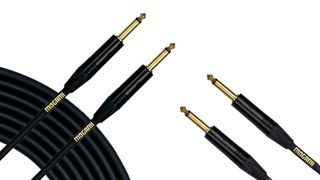 Mogami Gold Series guitar cable connectors
Mogami Gold Series guitar cable connectors
For unparalleled performance, Mogami Gold cables are the top choice for guitarists seeking the ultimate signal purity.
1. Mogami Gold Series Guitar Cable
The Gold Standard in Guitar Cables
Expert Review:
The Mogami Gold Series guitar cable is widely recognized as the best guitar cable available, and for good reason. It’s the benchmark against which all other premium cables are measured.
Specifications:
- Features: Oxygen-Free Copper (OFC) conductor, Carbon-impregnated PVC shield, Neutrik black and gold connectors, Ultra-High Density (UHD) spiral shield, Conductive polymer sub-shield, Lifetime warranty, 130pF/m capacitance.
- Connection: 1/4” Straight-to-Straight, Straight-to-Right Angle.
- Length Options: 3ft, 6ft, 10ft, 12ft, 15ft, 20ft, 25ft.
Reasons to Buy:
- Unrivaled Noise Rejection: The combination of UHD spiral shield, conductive polymer sub-shield, and carbon-impregnated PVC effectively eliminates unwanted noise and interference, preserving the purity of your guitar signal.
- Lifetime Warranty: Mogami’s “no excuses” lifetime warranty speaks volumes about their confidence in the durability and longevity of these cables.
- Wide Range of Lengths: Available in various lengths to suit any setup, from compact pedalboards to expansive stages.
Reasons to Avoid:
- Premium Price: Mogami Gold cables are a significant investment, reflecting their top-tier quality.
- Overkill for Some: The exceptional quality might be considered excessive for casual players or beginners.
The Mogami Gold Series employs an Ultra-High Density (UHD) spiral shield and a conductive polymer sub-shield, a formidable combination that effectively combats noise and ensures pristine signal transmission. The conductive carbon-impregnated PVC layer further minimizes microphonic noise often encountered with lesser cables, especially when handling or moving.
Despite its heavy-gauge copper core conductor, the Mogami Gold Series cable remains remarkably flexible and easy to manage. Gigging musicians who frequently switch instruments on stage may find the Mogami Gold Series Silent particularly appealing. These cables incorporate Neutrik silent plugs, allowing for seamless instrument changes without the need to mute or switch off the amplifier, preventing unwanted pops and hum.
Backed by a comprehensive lifetime warranty and available in a wide array of lengths, the Mogami Gold Series is a testament to uncompromising quality. While the premium price point might seem extravagant to some, for those who demand the absolute best in signal integrity and durability, it’s an investment that pays dividends in superior tone and reliable performance.
Best on a Budget
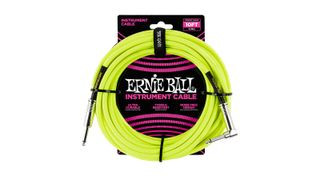 Ernie Ball Braided guitar cable
Ernie Ball Braided guitar cable
Ernie Ball Braided cables offer exceptional quality and durability at a price point accessible to budget-conscious guitarists.
2. Ernie Ball Braided Guitar Cable
Road-Ready Performance Without Breaking the Bank
Expert Review:
Ernie Ball Braided guitar cables strike an impressive balance between affordability and performance, making them a top choice for guitarists seeking quality on a budget.
Specifications:
- Features: Dual conductors, Tangle-resistant braided jacket, 99.95% Oxygen-Free Copper (OFC) conductors, Dual-shielded design, Dual-conductor design.
- Connection: 1/4” Straight-to-Straight, Straight-to-Right Angle.
- Length Options: 10ft, 18ft, 25ft.
Reasons to Buy:
- Exceptional Durability: The braided jacket exterior provides robust protection against wear and tear, making these cables ideal for demanding use.
- Tangle-Resistant Design: The braided jacket also minimizes tangling, a practical feature for gigging musicians and players who prioritize quick setup and teardown.
- Noise-Free Performance: The dual-shielded, dual-conductor design effectively reduces noise and preserves signal clarity.
Reasons to Avoid:
- Limited Length Options: Shorter lengths than 10ft are not available in the braided series.
Ernie Ball has built a reputation for producing reliable and durable guitar accessories, and their braided cables are no exception. These cables are specifically engineered to withstand the rigors of frequent use, particularly for musicians who are constantly on the go. The braided construction not only enhances durability but also makes them remarkably tangle-resistant – a boon for guitarists who prioritize convenience and efficiency. Whether you neatly coil your cables or prefer a more casual approach, Ernie Ball Braided cables are designed to handle it.
Internally, these cables feature dual conductors to ensure your guitar’s sonic nuances are faithfully transmitted. Our testing revealed a balanced frequency response, characterized by crisp highs, articulate mids, and rich harmonic content. The robust internal shielding further contributes to noise reduction and signal preservation, resulting in a clean and articulate tone.
While the length selection is somewhat limited to 10, 18, and 25-foot options, Ernie Ball Braided cables offer a compelling combination of durability, sound quality, and value, making them an excellent choice for budget-conscious guitarists who refuse to compromise on performance.
Best for Options
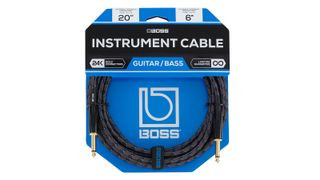 Boss Instrument Cable in blue packaging
Boss Instrument Cable in blue packaging
Boss Instrument Cables stand out for their extensive range of lengths and configurations, catering to diverse player needs.
3. Boss Instrument Cable
Quality and Versatility in One Cable
Expert Review:
Boss Instrument Cables are renowned for their blend of quality construction, reliable performance, and exceptional value, making them a versatile choice for a wide range of guitarists.
Specifications:
- Features: Studio-grade Oxygen-Free Copper (OFC) core wire, 24K Gold-plated contacts, Heavy-duty braided shield.
- Connection: 1/4” Straight-to-Straight, Straight-to-Right Angle.
- Length Options: 1ft, 3ft, 5ft, 10ft, 15ft, 20ft, 25ft.
Reasons to Buy:
- Extensive Length Selection: Boss offers an unparalleled variety of lengths, from short patch cables to long runs, ensuring a perfect fit for any setup.
- Excellent Value for Money: These cables deliver a high level of quality and performance at a competitive price point.
- Durable Construction: Built with robust materials and construction techniques, Boss cables are designed for long-lasting reliability.
Reasons to Avoid:
- Not Top-Tier Premium: While excellent, they may not match the absolute pinnacle of performance offered by ultra-premium cables like Mogami Gold.
Boss Instrument Cables provide a compelling combination of quality and affordability, making them a smart choice for guitarists who demand reliable performance without exceeding their budget. The moment you handle a Boss cable, the quality is immediately apparent. Constructed with premium materials, they maintain the integrity of your guitar’s inherent tone without noticeable coloration or signal degradation.
The heavy-duty braided shielding effectively minimizes unwanted microphonic noise, ensuring a clean and quiet signal path. The connectors feel robust and securely attach to instruments and amplifiers. Furthermore, the cable material exhibits excellent flexibility, making coiling and storage effortless, contributing to the cable’s longevity with proper care.
The standout feature of Boss Instrument Cables is their exceptional range of lengths. Whether you require short patch cables for a pedalboard or longer cables for stage use, Boss has you covered. Angled jack options further enhance versatility, accommodating various instrument and amplifier jack configurations. While Boss also offers a premium cable range for those seeking even higher performance, their standard instrument cables represent an outstanding balance of quality, value, and versatility.
Also Consider
While our top picks cater to the majority of guitarists, the following cables offer specialized features and performance characteristics for specific needs and preferences.
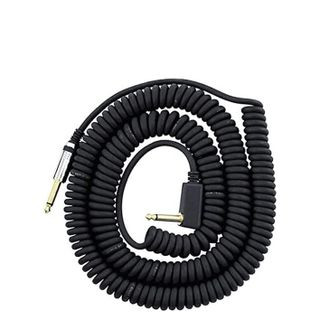 Vox Premium Vintage Coiled cable
Vox Premium Vintage Coiled cable
Vox Premium Vintage Coiled cables combine iconic aesthetics with high-quality construction for players seeking vintage vibe.
4. Vox Premium Vintage Coil
Best Coiled Cable
Connection: 1 x 1/4″ straight, 1 x 1/4″ right-angle jack
Length: 30ft (9m)
Pros:
- Iconic Vintage Aesthetic: Captures the classic coiled cable look synonymous with vintage rock and roll.
- High-Quality Construction: Made with premium materials for reliable performance.
- Excellent Build Quality: Robustly constructed to withstand regular use.
Cons:
- Coiled Cable Aesthetics: The coiled look may not appeal to all players.
For guitarists who embrace vintage aesthetics, the Vox Premium Vintage Coil cable is the quintessential choice. Coiled cables evoke a classic rock and roll vibe, and Vox delivers this iconic look with a cable that performs as well as it looks. Despite some guitarists and audiophiles criticizing coiled cables for potentially compromising sound quality, Vox dispels this myth with the Premium Vintage Coil.
The secret lies in the high-quality wire used in its construction. Made with 99.9% purity Oxygen-Free Copper (OFC), this cable delivers a warm and articulate tone, particularly accentuating the midrange frequencies, contributing to the sought-after vintage sound. The build quality is exceptional, incorporating dual shielding to enhance durability and minimize noise and interference. While the coiled aesthetic is subjective, for players who prioritize vintage vibe and tone, the Vox Premium Vintage Coil is an exceptional option.
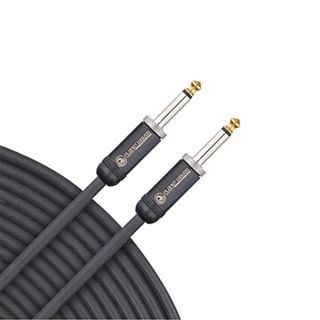 D’Addario Planet Waves American Stage Cable
D’Addario Planet Waves American Stage Cable
D’Addario Planet Waves American Stage cables are engineered for live performance, featuring robust construction and reliable connections.
5. D’Addario Planet Waves American Stage
Best for Live Performance
Features: 22 gauge Oxygen-Free Copper (OFC) twisted pair conductors, 95 percent tinned copper braid shielding, Geo-Tip plugs, approx 92pF/m capacitance
Connection: 1/4” Straight-to-Straight, Straight-to-Right Angle
Length: 10ft, 15ft, 20ft, 25ft, 30ft
Pros:
- Geo-Tip Plugs: Patented Geo-Tip plugs ensure a secure and reliable connection with various guitar jacks.
- Low Capacitance: Minimizes signal degradation and preserves high-frequency response.
Cons:
- Limited Outer Jacket Options: Fewer choices in terms of outer jacket aesthetics.
- Not Ultra-Premium: While high-quality, not positioned at the absolute top of the premium cable spectrum.
D’Addario Planet Waves American Stage cables are specifically designed for the demands of live performance. A key feature is their patented Geo-Tip plugs, engineered in collaboration with Neutrik in Liechtenstein. These plugs boast a slightly flattened tip and extended shield, ensuring a snug and reliable connection with virtually any guitar jack, eliminating crackling or popping noises. The tinned-copper braid shielding further protects against external interference, maintaining signal integrity on stage.
HelioFused soldering, a proprietary process unique to Planet Waves, creates a robust 180-degree inline connection, enhancing the American Stage cable’s durability and stage-worthiness. These cables are also readily available and offered at a competitive price point, with right-angle options for added versatility. For gigging musicians seeking dependable performance and robust construction, the D’Addario Planet Waves American Stage is an excellent choice.
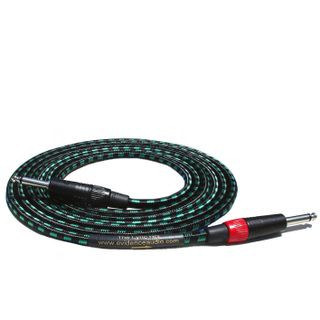 Evidence Audio Lyric HG guitar cable
Evidence Audio Lyric HG guitar cable
Evidence Audio Lyric HG cables are favored by discerning musicians for their exceptional signal purity and robust durability.
6. Evidence Audio Lyric HG Guitar Cable
Best Durability
Features: Dual solid-core conductors made of refined IGL copper, braided copper shielding, tough nylon/rubber outer jacket
Connection: 1/4″ phone plug input, straight plug output
Length: 10ft, 20ft
Pros:
- Exceptional Signal Purity: Dual solid-core conductors deliver a noticeably cleaner and more transparent signal path.
- Incredibly Robust: Built to withstand demanding use and offer long-lasting performance.
- Expertly Crafted: Meticulously engineered and constructed with premium components.
Cons:
- High Price: A significant investment, reflecting its top-tier quality and performance.
Evidence Audio Lyric HG cables are revered by professional guitarists like David Gilmour, Jeff Beck, and John Mayer for their uncompromising signal fidelity and exceptional durability. The core of the Lyric HG’s performance lies in its dual solid-core conductors, crafted from refined IGL copper. This design results in a demonstrably purer signal path and superior tone compared to conventional multi-strand cables. While the solid-core construction makes the cable slightly less flexible, the braided copper shielding and tough nylon/rubber outer jacket ensure exceptional robustness and longevity.
Despite the premium price, our testing confirmed that the Lyric HG’s performance justifies the investment. The level of signal clarity and tonal transparency is unmatched, making it a worthwhile upgrade for discerning players who demand the absolute best. If it’s good enough for guitar icons, it’s certainly worth considering for serious tone enthusiasts.
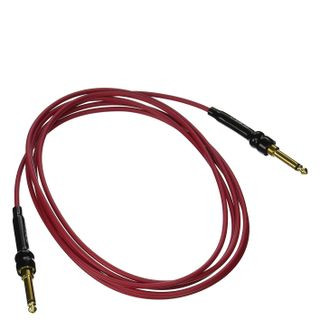 George L’s .155 cable
George L’s .155 cable
George L’s .155 cables are favored for their lightweight design, low capacitance, and solder-less connectivity.
7. George L’s .155 Guitar Cable
Best Lightweight Cable
Features: Solder-less connection, George L’s .155 connectors, high-density braided shielding, 67pF/m capacitance
Connection: 1/4” Straight-to-Straight, Straight-to-Right Angle
Length: 10ft, 20ft
Pros:
- Low Capacitance: Minimizes high-frequency roll-off, preserving a bright and articulate tone.
- Lightweight and Tough: Combines a lightweight feel with surprising durability.
Cons:
- Solder-less System Required: To fully utilize its features, you ideally need George L’s solder-less connectors.
- Thin Cable Profile: The thin cable diameter may not appeal to players who prefer a more substantial feel.
George L’s .155 cables are renowned for their ultra-low capacitance and lightweight design. George Lewis famously sells his .155 cable in bulk, encouraging guitarists to leverage their solder-less connector system and create custom cable lengths. Eric Johnson, known for his meticulous attention to tone, is a prominent advocate of George L’s cables. Indeed, finding another guitar cable with a lower capacitance per meter is a challenge. The frequency response is exceptional, and the signal remains well-shielded despite the cable’s thin profile.
Pre-assembled George L’s .155 cables come equipped with their signature solder-less connectors. Despite the vintage-inspired thin diameter and slight coiling tendency, these cables are remarkably robust. For players who find the .155 gauge too slender, George L’s offers the .255 series, providing identical sonic performance in a thicker, heavier gauge cable.
 Fender Deluxe Series Instrument Cable
Fender Deluxe Series Instrument Cable
Fender Deluxe Series Instrument Cables offer a compelling combination of value and performance, backed by a lifetime warranty.
8. Fender Deluxe Instrument Cable
Best Warranty
Features: 24K Gold-plated connectors, 20 AWG 99.99 percent Oxygen-Free Copper (OFC) conductor, 95 percent braided Oxygen-Free Copper (OFC) shielding, molded plugs with strain relief, tweed outer jacket (various colors), hook-and-loop cable tie
Connection: 1/4” Straight-to-Straight, Right-Angle
Length: 5ft, 10ft, 15ft, 25ft
Pros:
- Excellent Value and Lifetime Warranty: Offers premium features and peace of mind at a competitive price.
- Included Cable Tie: A practical addition for cable management and organization.
Cons:
- Not Ultra-Premium: May not satisfy players seeking the absolute highest echelon of cable performance.
- Tweed Aesthetic: The tweed jacket may not align with all players’ aesthetic preferences.
Fender’s Deluxe Series Instrument Cables often fly under the radar, yet they deliver exceptional performance and value, underscored by a lifetime warranty. These cables offer premium features at a competitive price point. The custom-molded plugs incorporate strain relief, ensuring a secure and durable connection. The Deluxe Series shielding effectively minimizes extraneous noise, rivaling even more expensive cables in noise rejection.
While boasting a substantial 8mm diameter, these cables coil neatly and include a cable tie for organized storage. Sonically, they are characterized by a bright and transparent sound, particularly noticeable in the 10-foot length. The Fender Deluxe Series cables feel robust and road-worthy, making them a reliable choice for demanding musicians.
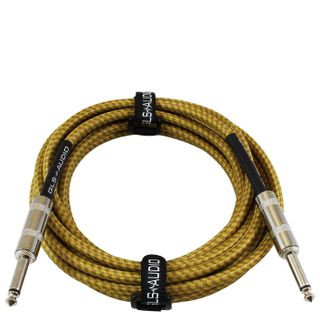 GLS Audio Tweed guitar cable
GLS Audio Tweed guitar cable
GLS Audio Tweed cables offer vintage aesthetics and high-quality construction at an exceptional value.
9. GLS Audio Tweed Guitar Cable
Best Vintage Style Cable
Features: Triple-strain relief, Oxygen-Free Copper (OFC) conductor and shielding, conductive PVC shield, plastic conductive carbon shield, approx 125pF/m capacitance, tweed jacket (brown or black)
Connection: 1/4” Straight-to-Straight, Straight-to-Right Angle
Length: 6ft, 10ft, 15ft, 20ft
Pros:
- Low Capacitance: Minimizes high-frequency loss, preserving a clear and bright tone.
- Clear and Bright Tone: Delivers accurate and articulate signal transmission.
Cons:
- Tweed Aesthetic: The tweed jacket may not appeal to all players.
GLS Audio Tweed guitar cables offer a compelling blend of vintage aesthetics, high-quality construction, and exceptional value. Purchasing directly from GLS often yields significant cost savings compared to retail prices. The tweed outer jacket exudes vintage charm, available in both classic black and brown options. The GLS Audio Tweed cable feels premium; it coils well, is demonstrably durable, and its vintage appeal is undeniable.
Internally, the cable features double shielding and low capacitance, ensuring quiet operation without sacrificing high-end frequencies. The performance is consistent across straight-to-straight and straight-to-right angle configurations. Our testing revealed that GLS Audio cables deliver a remarkably accurate and full-bodied reproduction of your guitar’s tone. For their price point, the performance is truly impressive, rivaling cables from more established brands in the same category.
How to Look After Your Guitar Cables
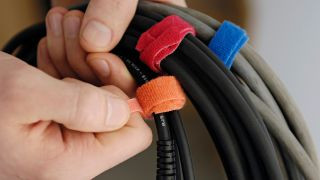 Man holding guitar cables with velcro ties
Man holding guitar cables with velcro ties
Proper cable care is crucial for maximizing the lifespan and performance of your guitar cables.
Investing in the best guitar cables is only half the battle; proper care is essential to maximize their lifespan and maintain optimal performance. Neglecting cable maintenance, even with high-quality cables, can lead to premature failure and signal degradation. Proper coiling, careful handling, and mindful stage setup are crucial for cable longevity.
Here are essential tips to ensure your guitar cables stand the test of time:
-
Pull the Plug – Correctly: Always grasp the plug itself when disconnecting cables, never pull on the cable. The cable conductors are soldered to the connector within the plug. Pulling on the cable can weaken or break this soldered joint, leading to signal issues and eventual failure.
-
The Musician’s Loop: Observe professional guitarists on stage; many loop their guitar cable through their strap. This technique serves two purposes: preventing accidental tripping and extending cable life by minimizing stress on the connector and cable itself while plugged in, preventing damage from accidental stomping. Similarly, looping the opposite end through your amplifier handle prevents accidental cable pull-out.
-
Tread Lightly: Minimize stepping on your guitar cables. During setup, prioritize positioning your amplifier, pedalboard, and guitar before connecting cables. This minimizes the risk of accidentally stepping on cables and causing damage.
-
Embrace the Angle: Right-angle cables are invaluable in specific scenarios where straight connectors can create excessive pressure or strain. For amplifiers with top-mounted input jacks, a right-angle cable relieves stress on the connection. Similarly, right-angle connectors on pedalboards reduce the risk of damage from accidental foot traffic.
-
Master the Wrap: Learning proper cable wrapping techniques is a fundamental skill for any musician or audio professional. Correctly wrapped cables remain organized, prevent tangling, and extend cable life. Studio and sound engineers will appreciate your organized approach, and it significantly streamlines setup and teardown. Numerous online tutorials demonstrate proper cable wrapping techniques.
FAQs
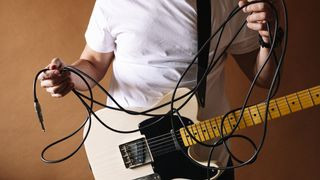 Man holding a guitar cable
Man holding a guitar cable
Addressing common questions about guitar cables to help you make informed decisions.
Do I need a different cable for acoustic, electric, or bass guitar?
No, a specific cable type is not required for different instrument types. Electric guitars, acoustic guitars, and bass guitars all utilize 1/4″ jack connections, making any standard instrument cable universally compatible. However, while the connector type is consistent, cable quality remains paramount regardless of instrument.
Consider the output jack location on your guitar when choosing between straight or angled jacks. Guitars with jacks on the face often benefit from angled cables. Conversely, some acoustic guitars are too bulky to accommodate angled connectors, making straight jacks a more suitable choice.
How long should a guitar cable last?
High-quality guitar cables are designed for durability. With proper care, expect several years of reliable performance, potentially extending well beyond a couple of years. Investing in quality cables translates to robust construction and premium components. Key factors to consider are the quality of the jack plugs and the cable material itself. Shielding around the cable core is also crucial for minimizing noise, especially when the cable is moved or handled.
What is cable capacitance?
Cable capacitance is an electrical property that affects your guitar tone. All cables exhibit capacitance, meaning they store a certain amount of electrical charge. Ideally, a guitar cable should facilitate signal flow without storing charge, allowing your signal to reach your pedals and amplifier unimpeded. Higher capacitance cables can cause a roll-off of high-end frequencies, resulting in a loss of treble in your tone. Conversely, low-capacitance cables preserve a fuller frequency response, delivering a more articulate and brighter sound. While the difference might not be drastic, it is perceptible, especially in discerning setups.
What length guitar cable do I need?
When selecting the best guitar cable, prioritize the shortest length practical for your setup. Similar to capacitance, longer cables can incrementally attenuate high frequencies. While tone shaping is sometimes desirable, generally, shorter, low-capacitance cables are preferred for optimal signal fidelity. Consider your stage setup and pedalboard layout to determine the appropriate cable length, minimizing excess cable runs.
How much should I spend on a guitar cable?
As with many things, price often reflects quality. While budget cables might seem tempting initially, the adage “buy cheap, buy twice” often applies. Super-budget cables are prone to noise, degrade tone, and fail prematurely. Investing in the best guitar cables ensures pristine signal transmission, preserves your rig’s sonic integrity, and withstands the rigors of regular use.
What are guitar cables made of?
Various materials are employed by different manufacturers, but copper is typically the core conductor material. While gold-plated jack plugs are common on premium cables, their impact on tone is negligible, primarily offering corrosion resistance. The quality of the copper, shielding, and outer jacket are more significant determinants of cable performance and durability.
Are guitar cables balanced?
Guitar cables are unbalanced, making them susceptible to external interference and microphonic noise. This vulnerability underscores the importance of investing in high-quality, well-shielded cables, particularly in complex pedalboard setups.
Guitar cables are mono, transmitting a single copy of your audio signal. Unbalanced cables, sending only one signal, are more prone to picking up extraneous noise along the cable path. Balanced cables, in contrast, transmit two copies of the signal, with one inverted. This inverted signal effectively cancels out common-mode noise picked up along the cable run.
Unfortunately, balanced cables are generally incompatible with standard guitar amplifier inputs, which typically require TS (Tip-Sleeve) connectors. Balanced cables utilize TRS (Tip-Ring-Sleeve) connectors. Balanced cables are commonly employed with synthesizers, studio monitors, PA systems, microphones, and in situations requiring cable runs exceeding 25 feet.
Can guitar cables cause buzz?
Pinpointing the exact source of buzz in a signal chain can be complex, as any component can potentially introduce noise. Even external electrical devices near your setup can contribute to buzzing. While a guitar cable isn’t always the primary culprit, it can certainly be a contributing factor.
The most effective method for isolating noise sources is systematic component testing. Test each element of your signal chain individually. While time-consuming, this methodical approach is often the only way to definitively identify the source of unwanted noise. Buzzing can also accumulate across multiple pedals or cables, necessitating a segmented approach to troubleshooting. Also, check for nearby electrical devices like computer monitors or mobile phones, as these can also induce unwanted noise in your signal.
How We Choose
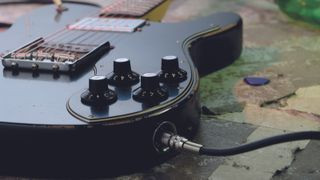 Guitar cable plugged into an electric guitar
Guitar cable plugged into an electric guitar
Our rigorous testing process ensures we recommend only the best guitar cables for discerning players.
The team at guitarplayers.net comprises experienced guitarists who rigorously test a wide array of guitar gear, including guitar cables. Our collective experience spans diverse playing scenarios, from festival stages to professional recording studios and regular band rehearsals. We are all committed to seeking out the best guitar tone possible.
For us, an exceptional guitar cable must excel across various criteria, with sound quality being paramount. Cheap cables introduce noise into your signal, which is unacceptable. Our initial test assesses noise performance, evaluating cables in direct instrument-to-interface setups and full gig rigs with amplifiers and pedalboards.
Durability is another critical factor. We subject cables to regular practice sessions, tours, studio recordings, and home use to assess their resilience under constant use. Our extensive experience allows us to quickly discern cable quality, particularly in the connectors, the most common point of failure.
Recognizing that player preferences vary, we aim to provide recommendations that cater to a broad spectrum of guitarists. While a universal “best” cable is subjective, our real-world experience enables us to recommend guitar cables that will suit the vast majority of players. As guitarists ourselves, we only recommend products we would confidently use ourselves, ensuring our recommendations are trustworthy and practical.
Learn more about our rigorous testing methodologies and review policies on our “How We Test” page.
